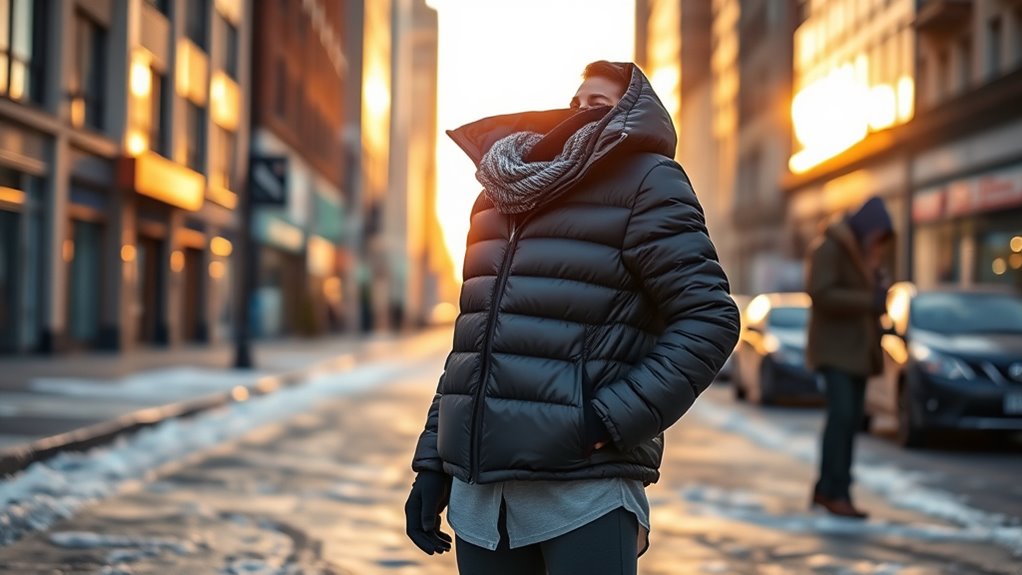To manage cold nights and hot days, layer smartly with breathable base layers like cotton or moisture-wick fabrics that keep you comfortable all day. Add a lightweight fleece or thin sweater as a middle layer for warmth, and top with a waterproof or windproof outer shell to protect against weather drops. Accessories such as hats, sunglasses, and scarves help adapt quickly to changing conditions. Keep exploring to discover how these layers can perfectly suit your needs.
Key Takeaways
- Use breathable base layers like cotton or moisture-wicking fabrics to stay comfortable in both conditions.
- Add or remove lightweight mid-layers such as fleece or thin sweaters as temperatures fluctuate.
- Choose a versatile, waterproof outer layer to protect against wind and rain when needed.
- Incorporate accessories like hats, sunglasses, or scarves to adapt quickly to sun or cold.
- Opt for easily removable layers to quickly transition from warm daytime to cool nighttime temperatures.

When the weather swings from cold nights to hot days, dressing smartly becomes essential. You need to stay comfortable and adaptable, which means mastering the art of layering. The key is to choose pieces that can be added or removed easily as temperatures fluctuate. Think lightweight fabrics and versatile styles that suit both chilly mornings and warm afternoons. Start with a breathable base layer, like a cotton or moisture-wicking shirt, to keep you comfortable no matter the temperature. This layer should be snug enough to trap body heat during the cooler hours but breathable enough to prevent overheating when the sun’s out.
Layer smartly with breathable, lightweight base pieces for comfort as temperatures change throughout the day.
Next, add a middle layer that provides insulation without bulk. A thin sweater, a fleece, or a long-sleeve shirt works well. This layer is your main insulator and should be easy to peel off when the day warms up. You want it to be lightweight but still capable of trapping heat. Avoid heavy or bulky layers that could make you sweat or feel uncomfortable as the day heats up. When it gets too warm, you simply remove this layer and carry it with you or tie it around your waist if needed. That way, you stay prepared without overheating.
The outer layer is your shield against wind, rain, or sudden temperature changes. A lightweight, waterproof jacket or windbreaker is perfect. It offers protection without adding unnecessary weight. When the sun is shining bright and the air is warm, you can leave it at home or stash it in a bag. When the wind picks up or clouds roll in, you can quickly put it on to stay dry and warm. The versatility of this layer is what makes it indispensable for unpredictable weather.
Accessories also play a vital role. A hat or sunglasses can shield you from the sun’s rays, while a scarf or buff can add warmth if the temperature dips unexpectedly. You can keep gloves handy if the nights are particularly cold but don’t want to carry bulky gear during the day. The goal is to have options that you can adapt on the fly, ensuring you’re comfortable no matter what the weather throws at you.
In essence, mastering layering means you’re prepared for the entire day—cool mornings, warm afternoons, and chilly evenings. Choose your pieces wisely, keep them lightweight, and stay flexible. With this approach, you’ll enjoy your day without discomfort or the hassle of carrying around heavy or unnecessary clothing. Incorporating versatile clothing that can easily transition between different weather conditions is a smart strategy to stay comfortable throughout the day.
Frequently Asked Questions
How Do I Prevent Overheating During Hot Days?
To prevent overheating during hot days, wear lightweight, breathable fabrics like cotton or linen. Opt for loose-fitting clothing that allows air circulation. Stay in the shade whenever possible and avoid direct sunlight during peak hours. Drink plenty of water to stay hydrated, and consider a wide-brimmed hat or sunglasses for added protection. You can also carry a portable fan or use cooling towels to stay comfortable throughout the day.
What Fabrics Are Best for Temperature Regulation?
Think of fabrics as your personal thermostat. Opt for breathable materials like cotton, linen, and bamboo—they wick away sweat and let air flow, keeping you cool. Avoid synthetic fibers that trap heat and moisture. Lightweight, loose-fitting clothes made from these fabrics act like a gentle breeze on a hot day, helping you stay comfortable and regulate your temperature effortlessly. Choose wisely, and you’ll stay cool no matter how high the temperature climbs.
How Can I Adjust Layers Quickly?
You can adjust layers quickly by choosing versatile, easy-to-remove pieces like zippered jackets or vests. Keep a lightweight scarf or hat handy for instant warmth, and opt for clothing with adjustable features like drawstrings or snaps. When the temperature changes, simply take off or add items as needed. Planning ahead with layered outfits guarantees you stay comfortable without wasting time, making quick adjustments effortless throughout your day.
Are There Stylish Layering Options for Formal Occasions?
Did you know that 65% of formal wear is now designed with layering in mind? For stylish formal layering, opt for sleek vests, tailored blazers, or elegant cardigans that add sophistication without bulk. You can also play with textured fabrics or subtle patterns to elevate your look. Keep your layers fitted and coordinated to guarantee you look polished, even when you need to adapt to changing temperatures throughout the event.
How Do I Care for Layered Clothing to Extend Its Lifespan?
To extend your layered clothing’s lifespan, always follow the care labels closely. Wash each piece separately using gentle cycles and cold water to prevent shrinkage and fading. Avoid overloading your washer, and air-dry whenever possible to prevent damage from heat. Store your layers properly, folding them neatly to avoid stretching. Regularly inspect for wear and tear, and mend small issues promptly to keep your wardrobe looking fresh and lasting longer.
Conclusion
Layering might seem tricky, but with the right approach, it keeps you comfortable no matter the weather. Think of it like building a sandwich: start with a lightweight base, add a warm middle layer, and top it off with a breathable shell. Even if the sun’s blazing, you can peel off a layer, just like removing bread from your sandwich. With these tips, you’ll stay cozy and cool—no matter how the weather shifts.










